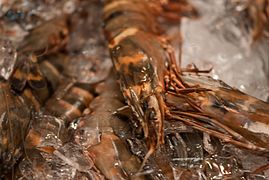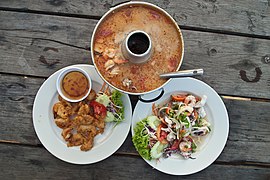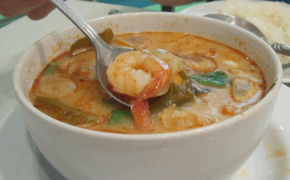Shrimp and prawn as food
 Marinated king prawns | |
| Nutritional value per 100 g (3.5 oz) | |
|---|---|
| Energy | 297 kJ (71 kcal) |
0.91 g | |
1.01 g | |
| Saturated | 3.98 g |
| Monounsaturated | 0.080 g |
13.61 g | |
| Vitamins | Quantity %DV† |
| Vitamin A | 180 IU |
| Vitamin D | 0% 2 IU |
| Minerals | Quantity %DV† |
| Calcium | 4% 54 mg |
| Iron | 1% 0.21 mg |
| Magnesium | 5% 22 mg |
| Phosphorus | 20% 244 mg |
| Potassium | 4% 113 mg |
| Sodium | 25% 566 mg |
| Zinc | 9% 0.97 mg |
| Other constituents | Quantity |
| Water | 83.01 g |
| Cholesterol | 0.0013 g |
| †Percentages estimated using US recommendations for adults,[1] except for potassium, which is estimated based on expert recommendation from the National Academies.[2] | |
Shrimp and prawn are types of sea animals that are consumed worldwide. Although shrimp and prawns belong to different suborders of Decapoda, they are very similar in appearance and the terms are often used interchangeably in commercial farming and wild fisheries. A distinction is drawn in recent aquaculture literature, which increasingly uses the term "prawn" only for the freshwater forms of palaemonids and "shrimp" for the marine penaeids.[3] They are the animals most commonly used and killed for food production.[4]
In the United Kingdom, the word "prawn" is more common on menus than "shrimp"; the opposite is the case in North America. The term "prawn" is also loosely used for any large shrimp, especially those that come 15 (or fewer) to the pound (such as "king prawns", yet sometimes known as "jumbo shrimp"). Australia and some other Commonwealth nations follow this British usage to an even greater extent, using the word "prawn" almost exclusively. When Australian comedian Paul Hogan used the phrase, "I'll slip an extra shrimp on the barbie for you" in an American television advertisement,[5] it was intended to make what he was saying easier for his American audience to understand, and was thus a deliberate distortion of what an Australian would typically say. In Britain very small crustaceans with a brownish shell are called shrimp, and are used to make potted shrimps. They are also used in dishes where they are not the primary ingredient. The French term crevette is often encountered in restaurants.
Shrimp and other shellfish are among the most common food allergens.[6] The Jewish dietary laws called Kashrut forbid the eating of shrimp.[7] Meanwhile, in Islamic dietary law, the Shafi'i, Maliki, Hanbali and Ja'fari schools allow the eating of shrimp, while the Hanafi school does not.
Nutrition[edit]
As with other seafood, shrimp is high in protein but low in food energy. A shrimp-based meal is also a significant source of cholesterol, from 122 mg to 251 mg per 100 g of shrimp, depending on the method of preparation.[8] Shrimp consumption, however, is considered healthy for the circulatory system because the lack of significant levels of saturated fat in shrimp means that the high cholesterol content in shrimp actually improves the ratio of LDL to HDL cholesterol and lowers triglycerides.[9]
Shrimp are high in levels of omega-3s (generally beneficial) and low in levels of mercury (generally toxic),[10] with an FDA study in 2010 showing a level of 0.001 parts per million, analysing only methylmercury.[11]
Preparation[edit]
Preparing shrimp for consumption usually involves removing the head, shell, tail, and "sand vein". A notable exception is drunken shrimp, a dish using freshwater shrimp that is often eaten alive, but immersed in ethanol to make consumption easier.[12]
To shell a shrimp, the tail is held while gently removing the shell around the body. The tail can be detached completely at this point, or left attached for presentation purposes.
Although the head and shell are generally removed before consumption, they are edible when cooked.[13]
There's a million ways to cook shrimp... shrimp is the fruit of the sea. You can barbecue it, boil it, broil it, bake it, saute it. Dey's uh, shrimp-kabobs, shrimp creole, shrimp gumbo. Pan fried, deep fried, stir-fried. There's pineapple shrimp, lemon shrimp, coconut shrimp, pepper shrimp, shrimp soup, shrimp stew, shrimp salad, shrimp and potatoes, shrimp burger, shrimp sandwich...
American soldier Benjamin Buford "Bubba" Blue, in the 1994 drama-comedy film Forrest Gump
Removing the "sand vein" (a euphemism for the digestive tract) is referred to as "deveining". The sand vein can be removed by making a shallow cut lengthwise down the outer curve of the shrimp's body, allowing the dark ribbon-like digestive tract to be removed with a pointed utensil. Special deveining tools are sometimes used but knives, skewers, and even toothpicks can be used to devein.[14][15] Alternatively, if the tail has been detached, the vein can be pinched at the tail end and pulled out completely with the fingers. On large shrimp, the "blood vein" (a euphemism for the ventral nerve cord) along the inner curve of the shrimp's body is typically removed as well. The shrimp is then rinsed under cold running water. Removing the vein is not essential, as it is not poisonous and is mostly tasteless.[16] Deveining does slightly change the flavor and makes it more consistent.[17] Shrimp also sometimes consume small amounts of sand and the vein might thus be gritty.
Shrimp and prawns are versatile ingredients. Common methods of preparation include baking, boiling, frying, grilling and barbequing. They are as delicate as eggs with regard to cooking time. When they are overcooked, they have a tough and rubbery texture.

Recipes using shrimp form part of the cuisine of many cultures. Strictly speaking, dishes containing scampi should be made from the Norway lobster, a shrimp-like crustacean more closely related to the lobster than shrimp. Scampi is often called the "Dublin Bay prawn", and in some places it is quite common for other prawns to be used instead.
Wet shrimp is commonly used as a flavoring and as a soup base in Asian cuisines while fried shrimp is popular in North America. In Europe, shrimp is very popular, forming a necessary ingredient in Spanish paella de marisco, Italian cacciucco, Portuguese caldeirada and many other seafood dishes. Shrimp curry is very popular in South Asia and Southeast Asia. Shrimp are also found in Latin and Caribbean dishes such as enchiladas and coconut shrimp. Other recipes include jambalaya, okonomiyaki, poon choi and bagoong. Shrimp are also consumed as salad, by frying, with rice, and as shrimp guvec (a dish baked in a clay pot) in the Western and Southern coasts of Turkey. In the subject of Japanese sushi, shrimp has long been valued as the "king of sushi-dane", as its composition can be either raw or cooked, and its latter preparation has often been considered a good introduction or choice for those unfamiliar to eating sushi, especially dishes involving raw fish.
Shrimp could also be fermented into shrimp paste in South East Asia and China.[18]
Marketing[edit]
Shrimp are marketed and commercialized with several issues in mind. Most shrimp are sold frozen and marketed based on their categorization of presentation, grading, colour and uniformity.[19]
-
Shrimp chilled with ice in a market
-
Split raw shrimp
-
Frozen shrimp
Prawn dishes[edit]
Many various dishes are prepared using shrimp as a primary ingredient. Ebiko, or shrimp roe, sometimes translated as "shrimp flakes", is used as an ingredient in the preparation of sushi.[20] There also exists popcorn shrimp, garlic butter shrimp, and breaded or battered deep-fried small shrimp.
-
Thai seafood set, shrimp soup, shrimp salad and deep fried shrimp
-
Tom yum goong, a Thai prawn soup
-
A bowl of boiled shrimp
Fraud[edit]
Gel-injection adulteration[edit]
There is a growing food fraud concern in Asia–Pacific where where non-food grade gels are injected into shrimp and prawns to increase their weight and visual appeal. [21][22]
In 2022, Cambodia seized 7 tons of shrimp that had been injected with carboxymethyl cellulose (CMC) gel.[23] Three grams of CMC can be used to make 50 kilos of gel, which can be used for one tonne of shrimp.[24]
Laboratory testing[edit]
To combat food fraud, NIST offers Standard Reference Materials: Wild-caught Shrimp (RM 8258) and Aquacultured Shrimp (RM 8259) for testing.[25]
See also[edit]
| External videos | |
|---|---|
- Crayfish as food
- Culinary name
- Eating live seafood
- Fish as food
- Pain in crustaceans
- Seafood
- Shrimp fishery
References[edit]
- ^ United States Food and Drug Administration (2024). "Daily Value on the Nutrition and Supplement Facts Labels". Retrieved 2024-03-28.
- ^ National Academies of Sciences, Engineering, and Medicine; Health and Medicine Division; Food and Nutrition Board; Committee to Review the Dietary Reference Intakes for Sodium and Potassium (2019). Oria, Maria; Harrison, Meghan; Stallings, Virginia A. (eds.). Dietary Reference Intakes for Sodium and Potassium. The National Academies Collection: Reports funded by National Institutes of Health. Washington (DC): National Academies Press (US). ISBN 978-0-309-48834-1. PMID 30844154.
{{cite book}}: CS1 maint: multiple names: authors list (link) - ^ "Shrimp Aquaculture and the Environment - An Environment Impact Assessment Report, chapter 2; IAA report" (PDF). Indian Aquaculture Authority. 2001. Archived from the original (PDF) on 2011-07-16.
- ^ "Shrimp: The animals most commonly used and killed for food production". rethinkpriorities.org. Rethink Priorities. 2023-08-11.
- ^ Bill Baker & Peggy Bendel. "Come and Say G'Day!". Travel Marketing Decisions (Summer 2005). Association of Travel Marketing Executives. Archived from the original on November 4, 2007. Retrieved December 21, 2007.
- ^ "Common Food Allergens". Food Allergy & Anaphylaxis Network. Archived from the original on June 13, 2007. Retrieved June 24, 2007.
- ^ Yoreh De'ah - Shulchan-Aruch Archived 2012-06-03 at the Wayback Machine Chapter 1, torah.org. Retrieved 17 June 2012.
- ^ "Cholesterol Content in Seafoods". Retrieved January 7, 2007.
- ^ Elizabeth R. De Oliveira e Silva, Cynthia E. Seidman, Jason J. Tian, Lisa C. Hudgins, Frank M. Sacks & Jan L. Breslow (1996). "Effects of shrimp consumption on plasma lipoproteins" (PDF). American Journal of Clinical Nutrition. 64 (5): 712–717. doi:10.1093/ajcn/64.5.712. PMID 8901790.
{{cite journal}}: CS1 maint: multiple names: authors list (link) - ^ Smith, Katrina L.; Guentzel, Jane L. (2010). "Mercury concentrations and omega-3 fatty acids in fish and shrimp: Preferential consumption for maximum health benefits". Marine Pollution Bulletin. 60 (9): 1615–1618. Bibcode:2010MarPB..60.1615S. doi:10.1016/j.marpolbul.2010.06.045. PMID 20633905.
- ^ Mercury Levels in Commercial Fish and Shellfish (1990–2010) U.S. Food and Drug Administration. Accessed 8 January 2012.
- ^ Lin, E. (2006). "2 Live food or the fresh and the furious. Live drunken shrimp & live lobster sashimi". Deep End Dining. Retrieved May 20, 2016.
- ^ "A Very Good, Very Crunchy Reason to Not Peel Shrimp". Food52. 2017-09-07. Retrieved 2023-01-17.
- ^ "Shrimp Hints and Tips". whatscookingamerica.net. Sep 8, 2015. Retrieved Dec 31, 2022.
- ^ "How to Prepare and Devein Shrimp". www.recipetips.com. Retrieved Dec 31, 2022.
- ^ H-E-B's Guide on Storing and Deveining Shrimp
- ^ How to Devein Shrimp
- ^ "Is Shrimp Paste the Right Addition to Your Thai Pantry?".
- ^ Yung C. Shang, Pingsun Leung & Bith-Hong Ling (1998). "Comparative economics of shrimp farming in Asia". Aquaculture. 164 (1–4): 183–200. doi:10.1016/S0044-8486(98)00186-0.
- ^ "What is Masago? Ebiko? Tobiko?". www.koloajodo.com. Jan 26, 2016. Retrieved Dec 31, 2022.
- ^ "Food frauds - Intention, detection and management" (PDF). Food safety toolkit for Asia and the Pacific. Vol. 5. Bangkok: Food and Agriculture Organization of the United Nations (FAO). 2021. Retrieved 17 April 2024.
- ^ "Not so fresh: Aussie bound prawns injected with jelly". Yahoo News. 5 October 2016. Retrieved 17 April 2024.
- ^ "Read News More than 7 tons of shrimps injected with Carboxymethyl cellulose (CMC) gel found on the first month of 2022 ASEAN Consumer". Association of Southeast Asian Nations. February 1, 2022. Retrieved 17 April 2024.
- ^ "Crackdown on shrimp injected with gel". Vietnam Fisheries Magazine. September 15, 2017. Retrieved 17 April 2024.
- ^ "NIST's Shrimp and Salmon Reference Materials Could Help Combat Seafood Fraud". NIST. 8 September 2023. Retrieved 17 April 2024.
External links[edit]
 Media related to Shrimps or prawns as food at Wikimedia Commons
Media related to Shrimps or prawns as food at Wikimedia Commons Shrimp at the Wikibooks Cookbook subproject
Shrimp at the Wikibooks Cookbook subproject













